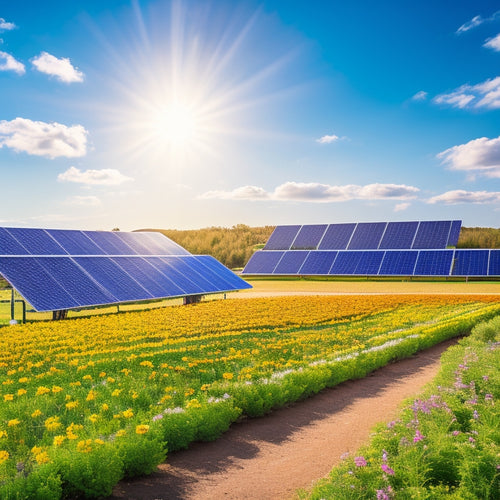
Understanding the Cost of a Home Solar Setup
Share
When understanding the cost of a home solar setup, you'll likely spend around $15,000 to $30,000 on a typical residential system. Solar panels account for nearly 50% of the total cost, with monocrystalline panels being the most efficient but expensive option. Inverters, mounting systems, and labor costs add to the overall expense. You'll also need to take into account permits, electrical connections, and potential additional costs like tree trimming. As you examine your solar options, you'll want to weigh the benefits of battery storage and monitoring systems, as well as ongoing maintenance and repair costs, to optimize your investment and energy independence.
Key Takeaways
- Solar panels account for nearly 50% of total solar installation costs, with monocrystalline being the most efficient and expensive option.
- Inverters, which convert DC power to AC, cost between $0.10 to $0.30 per watt, depending on the type and quality.
- Labor costs vary based on installation complexity and local rates, with typical costs ranging from $2,000 to $6,000.
- The Solar Investment Tax Credit (ITC) offers a 26% tax credit on total system cost, helping to offset the upfront expense.
- Ongoing maintenance, including regular inspections and cleaning, is crucial to ensure efficient operation and optimal energy production.
Breaking Down Solar Panel Costs
When considering a home solar setup, the single most significant expense is the solar panels themselves, accounting for nearly 50% of the total cost.
You'll want to understand the different types of solar panels and their associated costs. Monocrystalline silicon panels are the most efficient, but also the most expensive. Polycrystalline silicon panels are a more affordable option, offering a good balance between efficiency and cost. Thin-film panels are the least expensive, but also the least efficient.
Government incentives can help offset the cost of your solar panels. The Solar Investment Tax Credit (ITC) allows you to claim a tax credit of 26% of the total cost of your solar panel system.
Additionally, many states offer additional incentives, such as rebates or tax credits. Be sure to research the incentives available in your area to maximize your savings.
Inverter and Mounting Expenses
While solar panels get most of the attention, the inverter and mounting system are equally essential components of a home solar setup.
You'll need to evaluate the cost of these critical components when calculating the total expense of your system.
The inverter is responsible for converting the DC power generated by your solar panels into AC power that can be used in your home.
There are several inverter types to choose from, including string inverters, microinverters, and power optimizers.
String inverters are the most common and cost-effective option, but microinverters and power optimizers offer more flexibility and monitoring capabilities.
Expect to pay between $0.10 and $0.30 per watt for your inverter, depending on the type and quality.
The mounting system, which includes racking and tracking components, secures your solar panels to your roof or ground mount.
Mounting systems can be customized to fit your specific installation needs, and prices vary accordingly.
On average, you can expect to pay around $2,000 to $5,000 for a mounting system, depending on the complexity of the design and the type of materials used.
Installation Labor and Permits
Your solar setup's installation labor costs depend on the complexity of the job, the installer's knowledge, and the local labor rates. The more complex the installation, the higher the labor costs. For example, if you have a multi-story home with multiple roof angles, the installation will require more time and skill, increasing the labor costs.
To give you a better idea of the installation labor costs, here is a breakdown of the typical costs associated with different aspects of the installation process:
| Aspect of Installation | Typical Cost Range |
| Permitting and Inspection | $1,000 - $2,000 |
| Installation Labor | $2,000 - $4,000 |
| Electrical Connection | $500 - $1,000 |
| Installation Timeline | 1-3 days |
| Additional Costs (e.g. tree trimming) | $500 - $1,000 |
Keep in mind that these costs can vary depending on your location, the size of your solar setup, and the installer you choose. Additionally, you'll need to factor in the cost of permits, which can range from $1,000 to $2,000, depending on your local permit requirements. Understanding these costs will help you plan your installation timeline and budget accordingly.
Battery Storage and Monitoring
Several key components make up an extensive home solar setup, and battery storage and monitoring are vital among them. These components guarantee you maximize your energy independence and cost savings.
When it comes to battery storage, you'll want to evaluate the type and quality of batteries, as they directly impact your system's overall performance and battery lifespan. High-quality batteries with a longer lifespan can provide you with more energy independence and reduce your reliance on the grid.
Here are three key aspects to evaluate when assessing battery storage and monitoring for your home solar setup:
-
Battery Type and Quality: Choose batteries with a proven track record of performance and durability to guarantee a longer lifespan.
-
Monitoring Systems: Invest in advanced monitoring systems that provide real-time data on your energy production, consumption, and storage.
-
Energy Management: Opt for a system that allows you to manage your energy usage efficiently, directing excess energy to your battery storage for later use.
Ongoing Maintenance and Repair
One crucial aspect of confirming your home solar setup continues to operate efficiently is ongoing maintenance and repair. Regular maintenance helps to identify and address potential issues before they become major problems, optimizing your system's performance and extending its lifespan.
To give you a better idea of what's involved, here's a breakdown of typical maintenance tasks and their frequencies:
| Task | Frequency | Description |
|---|---|---|
| Visual Inspection | Quarterly | Check for signs of wear, damage, or debris on panels and equipment |
| Performance Monitoring | Ongoing | Track your system's energy production and identify potential issues through solar performance monitoring |
| Cleaning | Bi-annually | Clean panels to guarantee maximum energy absorption |
| Inverter Check | Annually | Verify inverter operation and perform firmware updates as needed |
| Full System Inspection | Bi-annually | Conduct a thorough inspection of the entire system to identify potential issues |
Frequently Asked Questions
Can I Install Solar Panels on a Rented Property?
You can investigate rented property options for solar panels, but you'll need to check local solar panel regulations, obtaining permission from your landlord and ensuring the system is removable when your lease ends.
Do Solar Panels Work During a Power Outage?
You'll find that solar panels won't provide power during a grid outage unless you have a battery backup system, as they're designed to sync with the grid's frequency, so they'll shut down to guarantee safety and prevent backfeeding.
Can I Sell Excess Energy Back to the Grid?
You can sell excess energy back to the grid through net metering options, earning energy credits that offset your utility bills; this process allows you to capitalize on your solar setup's overproduction, reducing your reliance on traditional power sources.
How Long Does a Typical Solar Panel Warranty Last?
You'll find that a typical solar panel warranty lasts around 25 years, covering defects and performance guarantees; manufacturers often offer separate warranty types, such as workmanship and materials warranties, which vary in coverage and duration.
Are There Any Government Incentives for Solar Energy?
As you commence on a quest for clean energy, you'll find the government is your ally, offering federal tax credits, state rebates, and local incentives, as well as solar grants to fuel your expedition, making your solar dreams more affordable and within reach.
Conclusion
As you stand at the threshold of utilizing solar power, the cost terrain unfolds before you like a puzzle. Each piece - panels, inverters, mounting, labor, permits, batteries, and maintenance - fits together to form a complete image. Like a sunrise, the total cost rises, illuminating the path to a brighter, more sustainable future. With every calculation, you're one step closer to revealing the full potential of your solar setup, and the savings that come with it.
Related Posts
-

Energy-Efficient Lighting Solutions for Sustainable Buildings
For sustainable buildings, energy-efficient lighting solutions, like LEDs, offer multiple benefits. These bulbs last ...
-

High-Performance Energy-Efficient HVAC Systems
High-performance energy-efficient HVAC systems are essential for reducing energy consumption while improving indoor c...
-

High-Performance Solar Solutions for Sustainable Living
High-performance solar solutions are your gateway to sustainable living, maximizing energy efficiency while considera...


